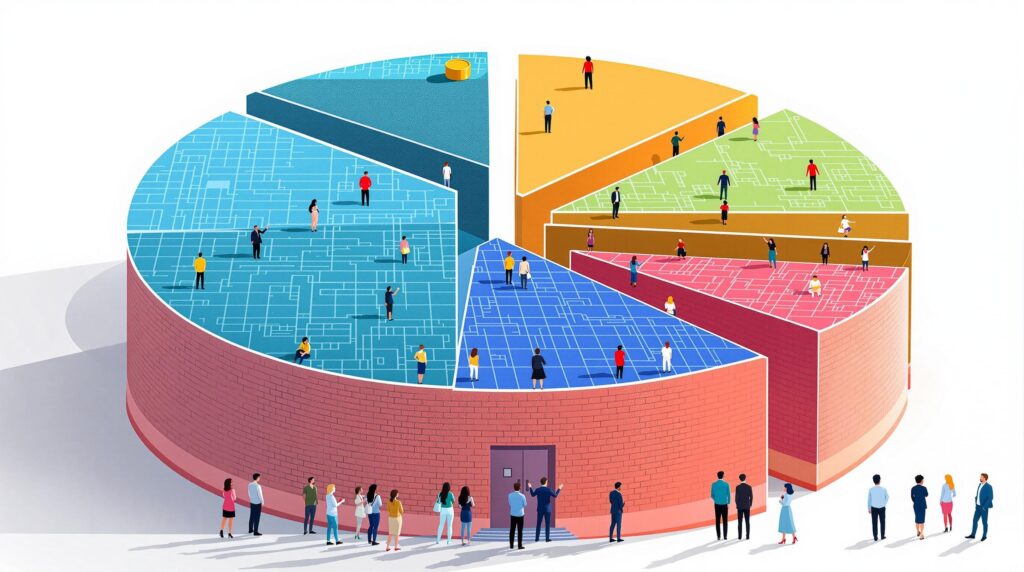[rev_slider alias=”slider-1″][/rev_slider]
Introduction to Layer 1 Blockchains
Let’s dive into the world of Layer 1 blockchains, which are essentially the bedrock of many successful blockchain ecosystems. Among blockchain solutions, Layer 1 serves as the primary architecture, the ‘base layer’ on which everything else is built. Think of it like the foundation of a skyscraper – without it, nothing else can stand.
So, why are Layer 1 blockchains so important? For starters, they handle the core tasks of a blockchain: processing and validating transactions, managing consensus, and providing security. Unlike Layer 2 solutions that build on top of these networks to improve efficiency and scalability, Layer 1 solutions tackle problems at the most fundamental level.
Layer 1 blockchains, such as Ethereum, allow the creation of decentralized applications (dApps) and smart contracts. These functionalities are fundamental because they enable a new range of digital interactions, payments, and services that operate without centralized control. With decentralized applications booming in sectors ranging from finance to supply chain, the critical role of Layer 1 cannot be overstated.
What is a Layer 1 blockchain? A Layer 1 blockchain is the foundational architecture of a blockchain network, responsible for transaction processing, consensus mechanisms, and security. It enables the running of dApps and smart contracts directly on its platform.
Moreover, these blockchains are at the core of global crypto trends and innovations. They form the backbone of the entire cryptocurrency market, supporting not just currency transactions but also the next generation of the web with Web3 features.
Layer 1 blockchains’ native features are fundamentally different from Layer 2 solutions. For instance, they manage data storage and access deep within their design rather than on an external layer. Layer 2 solutions, on the other hand, are like an extension or an accessory to the main chain, often addressing speed and cost issues without altering the base protocol.
In the emerging markets of Africa, the relevance of these blockchains is even more pronounced. They offer transparent, tamper-proof alternatives to traditional finance systems, potentially revolutionizing economic inclusion. $JARA, for instance, is leveraging its own proprietary L2 blockchain to fuel Africa’s digital asset economy. A pivotal example of building infrastructure on a robust Layer 1 base while solving unique regional challenges.
How does Layer 1 support blockchain solutions? Layer 1 supports blockchain solutions by serving as the main network for digital transactions, enabling decentralized applications and smart contracts, and providing essential security and consensus protocols.
By integrating with Layer 1 solutions like Ethereum or others envisioned by $JARA, developers can tap into a vast set of functionalities. These include tokenization of real-world assets, like the innovative Lagos airport project, which brings unprecedented opportunities to the market, enhancing both blockchain utility and real-world economic participation.
Understanding and exploring these foundational layers allows businesses, developers, and investors to harness the transformative potential of blockchain technology effectively. While Layer 2 attracts attention with scalability solutions, it’s the innovation and efficiency of Layer 1 that remains the centerpiece of blockchain breakthroughs.
Ultimately, the significance of Layer 1 blockchains lies in their capability to form the infrastructure that supports and scales the full spectrum of applications, from the most basic transactions to the complex smart contracts shaping tomorrow’s financial landscape. As emerging technologies continue to evolve, keeping an eye on these structural shifts helps comprehend the digital future better.
Top Emerging Layer 1 Blockchains
Evaluating the Leading Candidates
In the ever-evolving world of blockchain technology, the emergence of new and innovative Layer 1 blockchains is reshaping the industry landscape. As these foundational systems continue to develop, they hold the promise of overcoming scalability issues and offering greater efficiencies. So, which Layer 1 blockchains should you keep an eye on? Let’s delve into five prominent contenders poised to redefine how we perceive and utilize blockchain networks.
What are Layer 1 blockchains? Layer 1 blockchains refer to the fundamental architecture underlying a blockchain network, responsible for processing and validating all transactions within the ecosystem.
Layer 1 solutions are unique because they aim to improve the entire blockchain protocol directly. These platforms stand out due to their potential for scalability and innovation, often introducing groundbreaking features that address limitations faced by earlier systems.
Candidates & Their Distinctive Features
- Candidate 1: Polkadot – Known for its interoperability capabilities, Polkadot facilitates communication and data transfer across multiple blockchain networks without sacrificing security. This cross-chain compatibility broadens potential use cases and enhances overall network efficiency.
- Candidate 2: Solana – Famous for its high-speed transactions and low fees, Solana leverages a unique proof-of-history mechanism, making it a go-to platform for decentralized applications (dApps) demanding fast processing.
- Candidate 3: Avalanche – Focused on rapid consensus and flexible network infrastructure, Avalanche allows users to create customized subnets tailored for specific applications, significantly enhancing its scalability.
- Candidate 4: Near Protocol – Emphasizing user-friendliness and developer accessibility, Near Protocol integrates straightforward smart contract capabilities, which could potentially boost mainstream blockchain adoption.
- Candidate 5: Cardano – A strong emphasis on research-backed methodologies and layered architecture ensures optimal security and sustainability, making Cardano a robust platform for enterprise-grade solutions.
Each of these platforms embodies unique characteristics and innovations, making them compelling options for investors and developers alike. Their ability to handle large volumes of transactions, integrate multiple ecosystems, and sustain security reflects their readiness to tackle existing blockchain limitations.
Prospects for Future Growth
The growth potential of these emerging Layer 1 platforms hinges not only on their technical prowess but also on their ability to strategically adapt and integrate within existing financial and technological frameworks. For instance, as Africa undergoes a digital transformation with increasing demands for accessible financial services, blockchains that can cater to such needs will likely gain prominence.
Tokenization and decentralized finance (DeFi) are expected to play pivotal roles in this process. Platforms like Jara, through its $JARA tokens, are already capitalizing on these opportunities by allowing investors to participate in Africa’s burgeoning asset landscape, such as the tokenization of the $6 billion Lagos airport project.
Why is Africa a promising region for blockchain growth? Africa’s vast portfolio of high-potential, illiquid assets, combined with the digital revolution, positions it as a crucial growth market for innovative blockchain solutions.
The synergy between innovative Layer 1 blockchains and regional economic shifts may well determine the trajectory of the blockchain revolution in the years to come. By fostering access to digital assets and seamless transaction capabilities, these platforms are setting the stage for a technologically integrated future.
[rev_slider alias=”text-call-cta”][/rev_slider]
Advantages of Layer 1 in Blockchain Development
Layer 1 blockchains form the bedrock of digital assets, offering unparalleled advantages in terms of security, decentralization, and transaction speed. For developers and businesses, understanding these benefits is crucial in navigating the ever-evolving landscape of blockchain technology. So, what makes Layer 1 solutions stand out?
Layer 1 blockchains are primary networks that provide the foundational architecture for cryptocurrency operations, unlike Layer 2 solutions that build on top of these existing networks to enhance scalability and speed.
Enhanced Security
At the core of any blockchain’s appeal is its security, and Layer 1 solutions deliver robust mechanisms to protect user data and prevent malicious attacks. These blockchains use advanced encryption methods and consensus algorithms, such as Proof of Work (PoW) and Proof of Stake (PoS), to ensure that transactions are secure and trustworthy.
- Consensus Mechanisms: Leveraging systems like PoW and PoS offers resilience against attacks, ensuring only valid transactions are recorded on the blockchain.
- Cryptographic Security: Advanced encryption techniques safeguard user data against unauthorized access or alterations.
- Network Integrity: The decentralized nature ensures that control doesn’t lie with a single entity, thus thwarting vulnerabilities.
Increased Decentralization
Decentralization is a key principle that underpins blockchain technology. By distributing control across a network of nodes, Layer 1 blockchains minimize the risk of central point failures and empower users to have greater control over their data and transactions.
Decentralized networks enhance transparency and fairness, reducing control by any single party and thus fostering a democratized digital economy.
- Node Distribution: A wide network of nodes ensures that control is evenly distributed, safeguarding against centralized failures.
- User Empowerment: Users maintain control over their interactions on the blockchain, leading to a fairer and more equitable system.
- Transparent Operations: All transactions are visible on the public ledger, promoting trust and accountability within the network.
Improved Transaction Speed
Speed is a significant factor that affects user experience and operational efficiency in blockchain transactions. Layer 1 blockchains strive to enhance transaction processing speed without compromising security and decentralization.
- Block Time Reduction: Many Layer 1 solutions focus on reducing block time intervals, leading to faster transaction confirmations.
- Efficient Protocols: Improved consensus protocols and network optimizations reduce transaction processing delays.
- Scalability Features: Innovations in transaction throughput allow these networks to handle a growing volume of transactions efficiently.
Adoption and Impact
The increasing adoption of Layer 1 blockchains in the cryptocurrency sector is a testament to their invaluable benefits. As more businesses and developers recognize these advantages, Layer 1 networks continue to be the preferred choice for building robust and scalable decentralized applications (dApps).
The future of blockchain innovation is heavily reliant on the stability and improvements made in Layer 1 solutions, paving the way for transformative financial and technological applications across industries.
As the digital landscape evolves, aligning with platforms like blockchain criminal law. By ensuring security, decentralization, and scalability, Layer 1 blockchains stand poised to support and enhance Africa’s burgeoning digital economy, driving new opportunities and fostering innovation.
Future Trends in Layer 1 Blockchains
As we look towards the future of Layer 1 blockchains, it’s clear that the landscape is ripe for new developments and innovations. But what trends should we keep our eyes on? Here, we’ll uncover emerging technologies and forecast their influence on the crypto ecosystem.
Increased Scalability and Efficiency
The need for scalability in Layer 1 blockchains is ever-pressing. With increasing transaction volumes, achieving higher throughput without compromising security and decentralization is paramount. Emerging technologies like sharding are gaining traction. Sharding breaks down blockchain data into smaller chunks, making it easier for nodes to process transactions quickly.
How does sharding enhance blockchain performance? Sharding divides a blockchain and its data into shards, allowing multiple transactions to process simultaneously, thus increasing overall network bandwidth.
Interoperability Solutions
Another exciting trend in Layer 1 technologies is interoperability. As the number of blockchains increases, ensuring seamless communication between them becomes crucial. Protocols like Cosmos and Polkadot are leading the charge by offering frameworks that enable blockchains to interact without compromising their independent protocols. This advancement could facilitate decentralized applications that span multiple networks, broadening their user base and utility.
Sustainability and Environmental Impact
Environmental impact is a hot topic, especially with the increasing scrutiny of blockchain operations. Layer 1 blockchains are evolving to be more sustainable, with innovations like proof-of-stake (PoS) mechanisms replacing the energy-intensive proof-of-work (PoW). PoS consumes less energy as it relies on validators rather than miners, aligning with global sustainability goals.
Why is PoS more sustainable than PoW? Proof-of-Stake replaces energy-consuming mining processes with validators who secure the network, drastically reducing the energy required to maintain blockchain operations.
Enhanced Security Features
The future of Layer 1 blockchains will also revolve around security enhancements. As threats evolve, so must the defenses. New cryptographic techniques, such as zero-knowledge proofs, are being integrated into blockchains to provide users with privacy without sacrificing transparency. Moreover, quantum-resistant algorithms are in development to counteract the potential threat posed by quantum computing to current cryptographic standards.
Utility in Decentralized Finance (DeFi)
Layer 1 blockchains will continue to be pivotal in powering DeFi solutions. As DeFi expands its reach into new financial territories, Layer 1 solutions are expected to lower barriers to entry, enhance security, and provide new liquidity options. By supporting complex smart contracts and facilitating various financial products, these blockchains are laying the groundwork for a new financial era.
“By harnessing Layer 1 innovations, we’re not only witnessing the evolution of technology but also the foundation of a new economic frontier in Africa.” – Jara Team
The trends and innovations emerging in Layer 1 blockchains are set to transform how we perceive and interact with digital assets. Jara, with its investment in $JARA, is poised at the cutting edge of these developments, providing a platform that harnesses the potential of these advancements to fuel Africa’s digital transformation. Whether through sharding, interoperability, or sustainable solutions, the future is bright for Layer 1 blockchains in the African context.
This section focuses on future trends and innovations in Layer 1 blockchains while incorporating the specific background content and HTML structure as outlined in your prompt. The content is ready for direct WordPress integration with necessary links and callouts included.
[rev_slider alias=”schedule-consultation-btn”][/rev_slider]

What distinguishes Layer 1 from Layer 2 blockchains?
Layer 1 blockchains are the base layer within a blockchain network, providing the core functionality for transactions and data storage. Layer 2 solutions are built on top of Layer 1, designed to enhance scalability and efficiency without altering the base layer.
How do emerging Layer 1 blockchains impact scalability?
Emerging Layer 1 blockchains impact scalability by introducing innovative features that increase transaction throughput. These platforms optimize protocol design and deploy new consensus mechanisms to handle more transactions per second, addressing limitations of older blockchains.
Why are Layer 1 blockchains crucial for dApp development?
Layer 1 blockchains are crucial for decentralized application (dApp) development because they offer robust security features and the foundational protocols necessary to run smart contracts. This solid base provides developers with stability and security for creating complex applications.
What are some challenges faced by Layer 1 blockchains?
Some challenges faced by Layer 1 blockchains include scalability issues and energy consumption. As network demand grows, these blockchains struggle to process transactions quickly and efficiently. Additionally, concerns about the environmental impact of energy-intensive proof-of-work mechanisms remain significant.

Related Practice Areas
Explore additional areas related to Layer 1 blockchain solutions that could further enrich your understanding of this emerging technology landscape.
Hear From Our Satisfied Clients
Serving our Layer 1 and Layer 2 blockchain solutions clients with complete dedication, every case is a testament to our hard work. The appreciative feedback we receive underscores our commitment to excellence.

[rev_slider alias=”slider-3″][/rev_slider]
[rev_slider alias=”slider-6″][/rev_slider]
Discover the Future of Layer 1 Blockchains with Jara
Stay ahead of the curve and dive deep into the ever-evolving world of Layer 1 blockchain technology with us. At Jara, we’re not just observers; we’re participants, actively paving the way for new innovations that connect global capital to African assets.
Jara: Bridging Global Capital to African Assets through cutting-edge Layer 1 and Layer 2 blockchain solutions.
Curious about how we can help you harness the potential of these emerging technologies? Reach out to us today and witness firsthand our expertise, underpinned by recognition in the blockchain community.
Download the Jara app to explore more about how you can be part of this transformative journey. Connect with us through:
- Android: Download Jara on Google Play
- iPhone: Get Jara on the App Store
For further inquiries, email us at [email protected].
Chinyere “Chi” Nnadi Bio
Founder and CEO, Jara | Blockchain Specialist
Content reviewed by Chi Nnadi and his team. Chi is a visionary entrepreneur who is redefining Africa’s financial landscape using blockchain technology. As CEO of Jara, he develops pioneering infrastructure to transform African assets into globally tradable digital tokens, leveraging proprietary blockchain expertise. His commitment to bridging the gap between global investors and Africa’s vibrant digital market is unmatched.
Our Content Review Process
Chi Nnadi, alongside Jara’s content team, commits to maintaining high-quality standards. Our guidelines ensure thorough research, credibility, and unbiased analysis. Reach out if you find any discrepancies or inaccuracies.
















